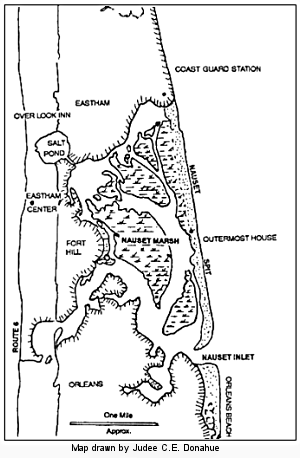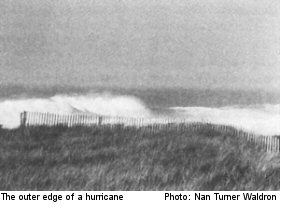Massachusetts Hails The Outermost House
The close identification of a specific venue with a particular work of art is not unusual. But when a magical and mysterious spot on the outer reaches of our continent inspires two separate portrayals in differing media, one based upon the other, both finding roots in the most elemental properties of life, in earth and sea and sky and light, then we are left with a set of commentaries and reflections upon the very essence of nature and the infinite variety of its manifestations.
The first to be drawn to the dunes of Nauset between Eastham and Orleans on Massachusetts' Cape Cod was Henry Beston, who wrote his classic observation The Outermost House in 1928. So vivid is Beston's book that it has gone through a great number of printings and many editions, all of which have established its author as a brilliantly insightful naturalist and have attracted a constant and ongoing throng of visitors who come in reverence each year to delve in the stark beauty of the Outer Cape.
The most recent artist to find enchantment in the Great Outer Beach is Ronald Perera, whose cantata The Outermost House received its world premiere on November 16 & 17, 1991 in West Yarmouth on Cape Cod. The 40-minute setting of Henry Beston's text for chorus of mixed voices with narrator, soprano solo, and chamber orchestra of ten players was commissioned by the Chatham Chorale in honor of its founding director Marjorie Bennett Morley. The performances, which featured soprano Nancy Armstrong and narrator Robert J. Lurtsema, were conducted by the Chatham Chorale's present director Margaret T. Bossi. The same forces presented the work at Smith College in Northampton, Massachusetts (where Perera is professor of music) on February 16, 1992. As in the Cape Cod performances, reviewers were unanimous in applauding Armstrong's ethereal singing and Lurtsema's fittingly salty personage in voice and demeanor.
Henry Beston was born in Quincy, Massachusetts in 1888. He attended Adams Academy and Harvard University, graduating from the latter with a master's degree in 1911. He was an ambulance corpsman in the French army in the early years of World War I and participated as an official observer in the U.S. submarine service in 1918. He lectured in American literature at the University of Lyons, France (1919-20) before becoming a successful editor for Atlantic Monthly. It was during the twenties that he began to make regular visits to Cape Cod, ultimately buying a small parcel of land in Eastham. During the summer of 1925, Beston designed and supervised the building of a tiny house (call The Fo'c'sle) on a dune overlooking the sea. "Having known and loved this land for many years," he wrote, "I built myself a house upon the beach. On its solitary dune my house faced the four walls of the world. I went there to spend a fortnight in September. The fortnight ending, I lingered on, and as the year lengthened into autumn, the beauty and mystery of this earth and outer sea so possessed and held me that I could not go. I made up my mind to remain and try living for a year on Eastham Beach."

In her beautifully illustrated book Journey to The Outermost House (1991, Butterfly & Wheel Publishers, Bethlehem, CT), Nan Turner Waldron writes: "Henry Beston never intended to live his life on the dunes of Nauset. He did not build the Fo'c'sle to get away from people, nor to hide from reality. He came to this place as a journalist gathering material, prepared to examine this setting first hand, responding to all the changes, alert to every character in the scene. Staying in his dune house he was able to experience, perhaps for the first time, a sense of belonging to the earth." Waldron gives us more than pictures and documents. She gives us the spirit of Henry Beston and, through him, a mosaic of "another kind of harmony, human, as well as that of the elements." [Beston's 1964 speech at a ceremony in his honor] "He came originally to the Great Outer Beach," she writes, "as a seeker—seeking not answers but connections…. He showed others that there is a basic human need to belong once again to the earth—that there are ways to open new doors for the human spirit. Few writers had expressed this better than Henry Beston in writing The Outermost House. He wrote from the depths of his soul."
Henry Beston deeded his house on the dunes to the Massachusetts Audubon Society in 1964. He died at his home in East Nobleboro, Maine, in 1968, just short of his 80th birthday. The Fo'c'sle was swept out to sea in the devastating Blizzard of '78, and The Outermost House became part of the natural history of the area.
Perera's musical setting of texts from The Outermost House is in thirteen highly evocative movements: 1. East of America (narrator and piano); 2. My Western Windows (soprano, chorus, and orchestra); 3. A New Sound on the Beach (narrator and percussion); 4. The Sea Has Many Voices (soprano, chorus and orchestra); 5. Now Come the Sea Fowl (narrator and orchestra) [ "I chanced to look up a moment at the southern sky, and there for the first and still the only time in my life, I saw a flight of swans. The birds were passing along the coast well out to sea, and their course was as direct as an arrow from a bow."]; 6. Glorious White Birds (chorus and orchestra); 7. A Year Indoors (narrator and orchestra) [ ". . .Animal life has disappeared into the chill air, the heavy lifeless sand. On the surface, nothing remains of the insect world." ]; 8. That Multiplicity of Insect Tracks (soprano and orchestra), 9. The Wreck of the Montclair (narrator, chorus and orchestra); 10. Night on the Great Beach (narrator and orchestra); 11. It Was Still Night (soprano, chorus and orchestra); 12. My Year Upon the Beach (narrator and piano) [ "My year upon the beach had come full circle; it was time to close my door. Seeing the great suns, I thought of the last time I marked them in the spring, in the April west above the moors, dying into the light and sinking. Now, once again the Hunter rose to drive summer south before him, and once again autumn followed on his steps. I had seen the ritual of the sun; I had shared the elemental world."]
A great anthem (13) concludes the work, hushed, full of hope and wonder. It takes its title from the opening line of the text: "Hold out your hands over the earth as over a flame. To all who love her, who open to her the doors of their veins, she gives of her strength, sustaining them with her own measureless tremor of dark life. Touch the earth, love the earth, honor the earth, her plains, her valleys, her hills and her seas; rest your spirit in her solitary places. For the gifts of life are the earth's and they are given to all, and they are the songs of birds at daybreak, Orion and the Bear, and dawn seen over ocean from the beach."

The textual quotes cited here will serve to illustrate the profound ecological message of the book, penned so many years before the travesties inflicted on our earth began to filter into the societal consciousness. While Cape Cod has been known for its stark beauty since time immemorial, it is only now becoming increasingly clear that we must take decidedly positive measures to protect the precious and sensitive nature of the Cape and of all our wounded world.
The premiere performance was not only and artistic triumph but a memorable public event, generating not only reviews in the general sense but even editorial comment in the Cape Cod Times: "Many privileged to hear portions in 'sneak previews' hail the result as a masterwork. Its 35 minutes vividly portray in music Henry Beston's distinguished, much-loved book about his year spent alone in a tiny cabin—destroyed by the legendary Blizzard of '78—on Nauset's Outer Beach…. The project unites Cape artistry, hard work, community service, entertainment, time, effort, generosity, and inspiration, all in harmony rarely realized. The Outermost House, wherever and whenever performed honors the man and the Cape that inspired it."
"…Chatham Chorale's premiere of The Outermost House by composer Ronald Perera was overwhelming in its power and beauty," wrote Dana Franchitto in The Cape Codder. "I never thought that Henry Beston's profound words could ever be set to music. Perhaps that is why Mr. Perera is writing music and I'm merely writing about music."
And Anna Credo, the reviewer for the Cape Cod Times, called the work "elegantly crafted and musically appealing, and stirring to the imagination as well as to the heart…. Perera's deft and imaginative musical scoring for both voice and instruments complements and projects the text in a uniquely compelling and at times highly exhilarating fashion…. Closing with a simple but profoundly moving choral setting of the text 'Hold out your hands over the earth as over a flame,' the 40-minute work drew a powerful response from the capacity audience and, among those standing and applauding vigorously, there was more than one glistening eye…. In The Outermost House Perera has created a musical setting that is more than just worthy of Beston's masterpiece. It is a work that deserves to be heard often and not just on Cape Cod."
|